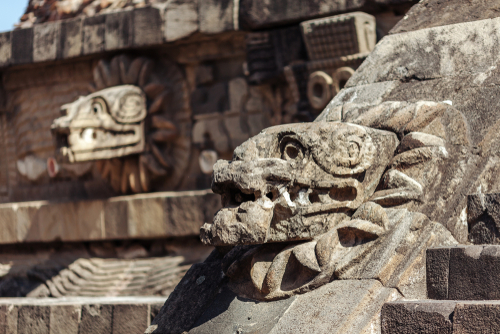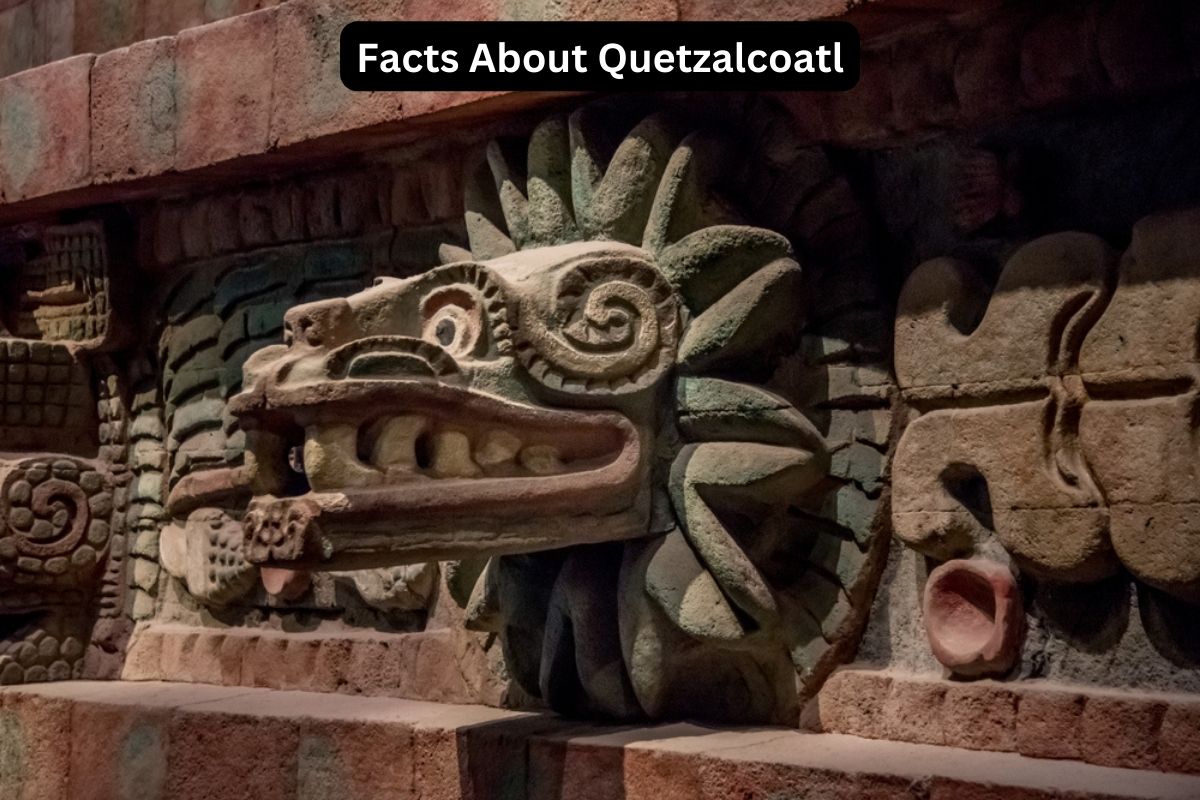Quetzalcoatl, the feathered serpent of Mesoamerican mythology, is a captivating figure whose influence transcends time and borders.
This deity, known for its dual nature as both a benevolent creator god and a fearsome deity, holds a central place in the cultural tapestry of pre-Columbian civilizations, particularly the Aztecs.
In this article, we delve into the intriguing world of Quetzalcoatl, uncovering some essential facts that shed light on this enigmatic and enduring symbol of ancient America.
From his association with creation and wisdom to the complex practices and beliefs that surrounded him, we’ll explore the multifaceted facets of Quetzalcoatl’s mythology and his continued presence in modern culture.
Quetzalcoatl Facts
1. Name means “feathered serpent”
Quetzalcoatl’s name is derived from the Nahuatl language, which was spoken by the Aztecs and other Mesoamerican civilizations. “Quetzal” refers to the quetzal bird, known for its vibrant and iridescent green feathers, while “coatl” means serpent.
Also Read: Famous Aztec Ruins
This combination represents the duality of earth and sky, as the quetzal bird was associated with the heavens, and the serpent represented the earth. Quetzalcoatl embodies this dual nature as a deity.

2. Associated with creation in Mesoamerican mythology
Quetzalcoatl played a central role in Mesoamerican creation myths. He was often depicted as one of the gods who participated in the creation of the world and humanity.
Also Read: Aztec Leaders in Order
His actions in shaping the cosmos and human destiny contributed to his status as a creator deity. His attributes, such as being the god of wind and rain, were closely tied to his role in sustaining and renewing life on Earth.
3. Prominent god in Aztec pantheon
Among the Aztecs, Quetzalcoatl was one of the most important gods in their pantheon. He was considered one of the “Tezcatlipoca,” the highest gods in Aztec mythology, alongside other deities like Huitzilopochtli and Tlaloc.
Quetzalcoatl was often depicted as a bearded man, sometimes with a serpent motif in his headdress and a conch shell ornament, holding a staff or a bundle of feathers.
He was associated with various aspects of Aztec life, including agriculture, knowledge, and the calendar, and played a vital role in their religious ceremonies and rituals.
His significance extended beyond the Aztecs to other Mesoamerican cultures, where he was revered under different names and variations.
4. Historically considered a ruler-priest
Quetzalcoatl is not only a mythical deity but was also believed by some Mesoamerican cultures to have been a historical figure.
In certain accounts, he was regarded as a legendary ruler-priest who lived around the 10th century AD and was associated with the city of Tula, also known as Tollan.
This historical aspect added complexity to his character, as he was seen as a wise and benevolent leader who brought prosperity and knowledge to his people.

5. Deity of wind, rain, and wisdom
Quetzalcoatl was closely associated with natural elements, particularly the wind and rain. He was often seen as a god who brought rain and controlled the weather, which was crucial for agriculture and the sustenance of Mesoamerican civilizations.
As a patron of wisdom and knowledge, he was revered as a deity who promoted learning, arts, and culture. His wisdom was considered valuable for both human progress and spiritual growth.
6. Symbolizes renewal and transformation
Quetzalcoatl’s symbolism is rich and multifaceted. The combination of the quetzal bird and the serpent in his imagery is thought to represent the cycle of life, death, and rebirth.
The serpent’s shedding of its skin was seen as a metaphor for renewal and transformation, reflecting the idea of cyclical renewal in nature.
Quetzalcoatl was often invoked during rituals and ceremonies to seek his blessings for agricultural fertility, ensuring that life would continually regenerate and flourish.
7. Human sacrifices were made in his name
In some Mesoamerican cultures, human sacrifices were offered to Quetzalcoatl, especially during times of drought or other natural disasters. These sacrifices were made in the belief that offering human blood to the deity would appease him and ensure favorable weather conditions, including rainfall and fertility for crops.
However, it’s important to note that the practice of human sacrifice varied across different regions and time periods within Mesoamerica, and not all cultures associated Quetzalcoatl with such rituals. Some civilizations practiced less gruesome forms of sacrifice, such as bloodletting or offering figurines made of precious materials.

8. Dual nature as both benevolent and wrathful
Quetzalcoatl’s character was complex, embodying both benevolent and wrathful aspects. While he was often seen as a patron of knowledge, arts, and life-giving rain, he was also believed to possess the power to bring destruction and chaos when angered.
This duality reflected the Mesoamerican worldview, where natural forces could be both beneficial and destructive, and deities represented these dualities in their various forms.
9. Influence of Christianity led to syncretism
With the arrival of Spanish conquistadors in the early 16th century and the spread of Christianity in the Americas, there was an effort to convert indigenous populations to Christianity.
Quetzalcoatl was sometimes syncretized with the figure of Jesus Christ, leading to a blending of indigenous beliefs with Christian iconography.
This syncretism aimed to make the transition to Christianity more palatable to the native population by connecting their traditional beliefs with the new religion, often incorporating elements like crosses and Christian saints into indigenous rituals and festivals.
10. Continues to be a symbol in modern culture
Quetzalcoatl’s legacy endures in various forms throughout modern Mexican and Central American culture. He remains a powerful symbol in art, literature, and even sports. The quetzal bird, named after this deity, is considered a symbol of freedom, beauty, and the vibrant biodiversity of Central America.
His imagery can be found in contemporary art and architecture, and his mythology continues to be a source of inspiration for storytelling and cultural expression in the region. Additionally, references to Quetzalcoatl can occasionally be seen in the context of indigenous cultural revitalization and pride.
